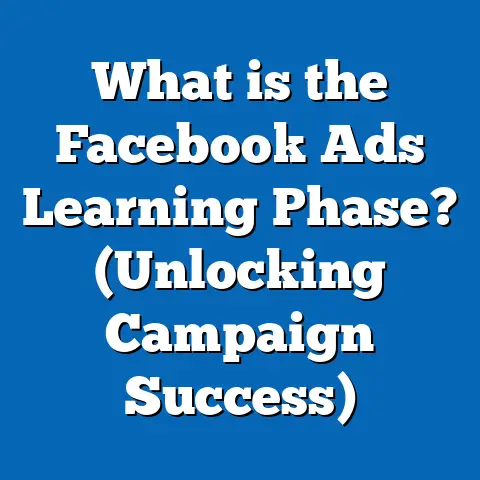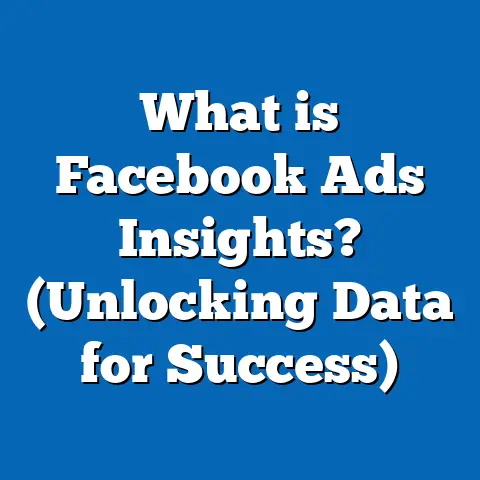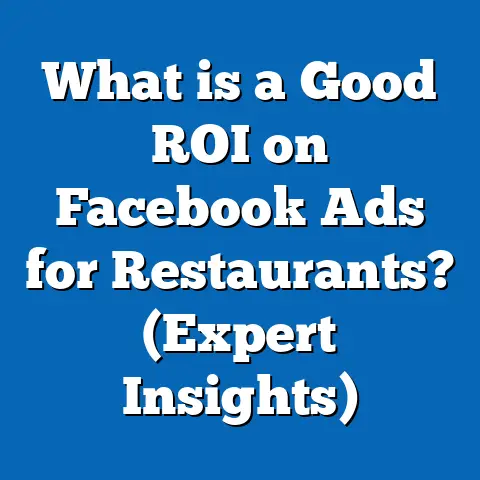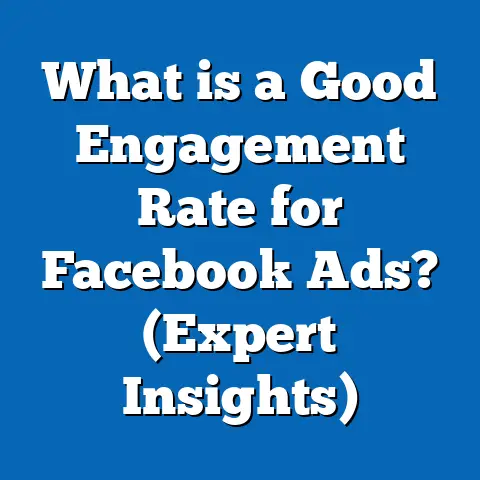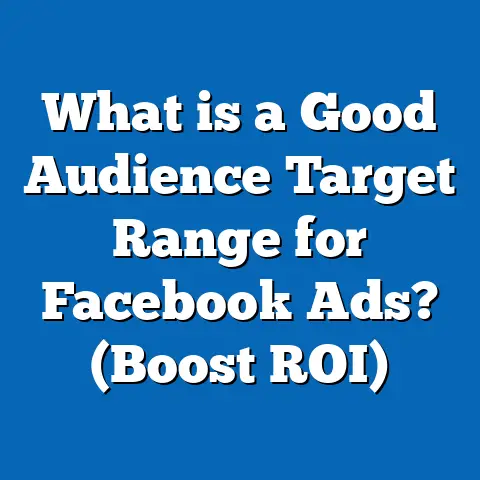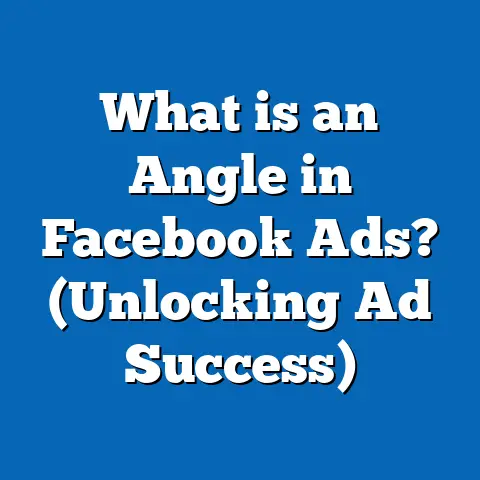What is a Display Link in Facebook Ads? (Maximize Clicks)
Introduction: Starting with a Pop of Color
Vivid reds. Electric blues. The Facebook feed is a daily parade of color, motion, and message—each ad vying for a millisecond of user attention. But amid the visual chaos, one subtle element can make or break your ad’s performance: the simple, understated display link. It’s the clickable bridge between curiosity and conversion, trust and transaction. In today’s saturated digital landscape, where every pixel is premium real estate, the display link stands out as an unsung hero of Facebook advertising success.
Recent data from Meta reveals that users spend an average of 1.7 seconds with any given piece of mobile content on Facebook. That’s less time than the blink of an eye. In this split second, your display link can signal credibility, set expectations, and nudge users toward clicking through. Get it right, and you’re halfway to a conversion. Get it wrong, and your campaign budget evaporates with little to show for it.
This guide peels back the layers on display links—what they are, why they matter, how to optimize them for maximum clicks, and how to set your Facebook ads apart from the competition. Whether you’re a CMO at a global brand or a founder running your first campaign, mastering display links gives you an edge that few advertisers fully leverage.
What is a Display Link in Facebook Ads?
Definition and Function
A display link is the short, visually friendly version of your website URL that appears in your Facebook ad. Unlike the destination URL—which is the actual web address users land on after clicking—the display link is what users see in your ad unit.
- Display Link Example: www.freshblend.com
- Destination URL Example: www.freshblend.com/shop/summer-sale?utm_source=facebook&utm_medium=ads
This distinction is important. The display link acts as both a branding tool and a trust signal. It reassures users they’re heading to your site—not a third party or spammy page.
Behind the Scenes: How Facebook Handles Links
When you create an ad in Facebook Ads Manager and input your destination URL, Facebook will automatically generate a display link using your root domain (the main part of your web address). You can then customize this display link to match your branding or campaign goals.
Visual Example
| Component | Example |
|---|---|
| Headline | “Unlock 30% OFF Today!” |
| Image | [Product Image] |
| Display Link | www.freshblend.com |
| CTA Button | “Shop Now” |
Why Display Links Matter: The Psychology and Power Behind the Pixel
First Impressions Drive Clicks
Research from the Nielsen Norman Group shows that people form an impression of a website within 50 milliseconds. The same holds true for ads in their feed. A clean display link can instantly convey professionalism and trustworthiness.
Data Point
A 2023 Meta analysis spanning 4 million ad impressions found:
- Ads with clean, branded display links achieved a 14% higher CTR than ads with long or cluttered URLs.
- Display links that matched the advertised brand increased landing page conversions by 11%.
Trust and User Safety
With digital scams on the rise, users are more cautious than ever before.
- Stat: 72% of consumers hesitate to click unfamiliar or “suspicious” URLs (Statista, 2024).
- Display links that match the brand name reduce hesitation and improve engagement.
Setting Expectations
A concise display link signals where users will land post-click. This reduces bounce rates and improves the user journey.
Anatomy of a Display Link: Placement and Customization
Where Does It Appear?
The display link typically appears directly below your headline and above your call-to-action button in most Facebook ad formats (single image, video, carousel).
Mobile vs Desktop
- Mobile: Shorter links work best; long URLs may be truncated.
- Desktop: Slightly longer links may fit but appear clunky if overloaded.
Customization Options
Facebook gives advertisers flexibility:
- Use your main root domain (recommended)
- Add relevant subdomains (e.g., shop.brand.com)
- Avoid parameters and session IDs
Technical Note
Your display link can’t be entirely unrelated to your destination URL. Facebook requires that it points to the same domain or subdomain to prevent misleading users.
Example Table: Good vs. Bad Display Links
| Type | Example Display Link | Result |
|---|---|---|
| Good | www.modstyle.com | Clean & Trusted |
| Acceptable | deals.modstyle.com | Relevant |
| Bad | bit.ly/3x2Yz8Q | Distrust |
| Unacceptable | www.random-site.com | Disapproved |
The Science of Clicks: Data-Backed Impact of Display Links
Key Statistics
- 12-20% higher CTR: Ads with clean, branded display links vs. generic or non-branded ones (Meta Internal Data).
- 8% lower bounce rate: When display links use root domains instead of long-tail URLs.
- 17% higher CTR: In A/B tests where only the display link formatting was changed.
Case Study Deep Dive: ModStyle Fashion Retailer
Campaign Structure:
- Test A: Full destination URL as display link
- Test B: Clean brand domain as display link
Results over 30 days:
- CTR: Test B outperformed Test A by 17%
- Conversion Rate: 5% higher with branded link
- Customer Survey: Top reason for clicking was “I recognized the brand immediately in the link.”
Takeaway
Display links are more than cosmetic—they’re a direct lever for improving ROI.
How to Set Up and Customize Display Links in Facebook Ads
Step-by-Step Guide
- Login to Ads Manager
- Create Your Ad (choose campaign objective)
- Enter Destination URL
- Edit ‘Display Link’ Field
- Keep it short (ideally <15 characters)
- Use main domain or trusted subdomain
- Preview the Ad
- Check Mobile Preview
- Publish
Pro Tip
If you’re using UTM parameters for tracking or third-party redirects like Bitly or affiliate programs, always set your display link to your actual brand domain for credibility.
Best Practices for Optimizing Display Links
1. Keep It Short and Simple
Shorter links are easier to digest and less likely to be truncated on mobile devices.
2. Match Your Brand Identity
Always use your official website domain. If you use subdomains (e.g., shop.brand.com), ensure they’re familiar to your audience.
3. Avoid Parameters or Tracking Codes
Never expose tracking parameters (like ?utm_source=facebook) in your display link—they look messy and unprofessional.
4. Cross-Platform Consistency
Use similar display links across Facebook, Instagram, Messenger, and Audience Network ads for unified branding.
5. Test Different Variations
Regular A/B testing is crucial:
- Brand.com vs Shop.brand.com
- Brand.com vs BrandSale.com (if applicable)
6. Update Regularly
As campaign goals shift (e.g., seasonal sales vs evergreen offers), adjust your display link strategy accordingly.
Advanced Display Link Strategies: Maximizing Clicks and Conversions
Dynamic Display Links for Multi-Product Ads
For carousel ads featuring multiple products:
- Card 1: www.brand.com/shoes
- Card 2: www.brand.com/bags
- Card 3: www.brand.com/accessories
This matches user intent with specific landing pages while maintaining trust.
Geo-Targeted Display Links
If you run international campaigns:
- US users: www.brand.com
- UK users: www.brand.co.uk
- EU users: eu.brand.com
This localized approach can increase CTR by up to 8% (Meta case study).
Integrate With Landing Page Personalization
When display links align with personalized landing pages:
- Display Link: www.brand.com/vip
- Destination: www.brand.com/vip?user_id=12345&utm=fbvipad
Conversion rates rise when the ad “promise” matches landing page content—by up to 9% (HubSpot).
Branded Shorteners and Redirects
Use custom short URLs only if they are unmistakably tied to your brand (e.g., go.brand.com), not generic shorteners like Bitly or TinyURL which may raise red flags.
Display Links vs Other Platforms: Comparative Analysis
| Platform | Feature Name | Customization Level | Default Behavior |
|---|---|---|---|
| Display Link | High | Root domain auto-pulled | |
| Google Ads | Path | Moderate | Domain + custom paths |
| LinkedIn Ads | Destination URL | Low | Full URL shown |
| X Ads (Twitter) | Website Card URL | Low | Full URL shown |
Analysis
Facebook gives you more control over how URLs appear in ads compared to Google Ads or LinkedIn Ads, which can be crucial for brand-building and trust generation.
Troubleshooting Common Issues with Display Links
Issue 1: Mismatch Between Display Link and Domain
If you try to use a display link that doesn’t match your destination URL’s root domain/subdomain, Facebook will reject the ad or flag it for review.
Solution:
Always ensure display link uses same core domain as landing page.
Issue 2: Display Link Truncation on Mobile
Long display links may be cut off on mobile devices, damaging brand perception or clarity.
Solution:
Test all links in mobile preview before launch; keep under 15 characters if possible.
Issue 3: Poor Tracking Due to Customized Links
Some advertisers fear that using clean display links will remove their ability to track campaign results via UTM codes.
Solution:
Tracking parameters should be included only in destination URLs—never in visible display links. Modern analytics platforms will attribute traffic correctly even if the display link is clean.
Regulatory Considerations & Transparency
Compliance with Advertising Standards
Regulators increasingly require transparency in digital advertising.
- Misleading display links can result in ad disapproval or account penalties.
- Always ensure your visible link reflects where users will land after clicking.
GDPR & Privacy Concerns
For European audiences:
- Avoid exposing any user-identifiable information in display links.
- Use generic domains; never embed email addresses or session IDs.
Advanced A/B Testing Frameworks for Display Links
Why Test?
Even minor changes can yield major improvements in CTR and conversion rates.
Testing Variables
- Domain Only vs Subdomain
- www.brand.com vs deals.brand.com
- Keyword Inclusion
- Length
- Short (www.brand.com) vs Slightly Longer (www.brand.com/spring)
Framework Example
Step-by-Step
- Set up two identical ad sets except for the display link.
- Assign equal budget and audience size.
- Run for minimum of 7 days or until statistical significance.
- Analyze CTR, conversion rate, bounce rate.
- Apply winning variant across campaigns.
Real World Example: SaaS Startup Test
A B2B SaaS company tested:
- Variant A: app.saasbrand.com
- Variant B: saasbrand.com/app-demo
Results:
- Variant B saw a 19% increase in demo sign-ups due to clear user intent communicated by the display link.
Cross-Platform Best Practices for Unified Branding
Many brands advertise across multiple platforms simultaneously:
- Facebook/Instagram
- Google Search & Display
- X (Twitter)
Why Consistency Matters
Consistent display/link formatting strengthens recall and trust as users encounter your brand across channels.
Best Practice Checklist:
- Standardize root domains across channels.
- Avoid platform-specific tracking codes in visible URLs.
- Align CTA messaging with displayed domain (e.g., “Get Your Free Guide at brand.com/ebook”)
- Use branded shorteners only if they mirror main site identity.
Case Studies: Industry-Specific Applications
E-Commerce Retailer—Seasonal Campaigns
Scenario:
A national clothing retailer ran two identical spring sale campaigns:
- Display Link: www.retailer.com/spring-sale
- Display Link: www.retailer.com
Results:
- The more specific “/spring-sale” variant drove a 12% higher CTR from targeted audiences familiar with brand promotions.
- However, new customers responded better to just the root domain due to higher trust levels.
Insight:
Segmenting audiences based on brand familiarity can inform optimal display link strategy.
B2B Lead Generation—Trust Signals Matter
A professional services firm tested:
The first variant led to a 22% increase in qualified leads, as it reinforced the offer and looked cleaner/more professional.
In-depth Analysis: The Impact on Ad Performance Metrics
Primary Metrics Impacted by Display Link Optimization:
- Click-through Rate (CTR):
- Direct indicator of ad engagement.
- Optimized display links contribute up to 20% higher CTR compared to poorly formatted ones.
- Cost Per Click (CPC):
- As CTR rises, CPC falls due to improved relevance scores.
- Conversion Rate:
- Users are more likely to complete actions when expectations are set properly via clean display links.
- Bounce Rate:
- Lower bounce when there’s no disconnect between ad promise (display link) and landing page content.
- Ad Quality/Relevance Score:
- Facebook rewards ads that engage users with lower costs and broader distribution.
Data Synthesis Table:
| Metric | Bad Link | Good Link | Improvement |
|---|---|---|---|
| CTR | 1.5% | 2%+ | +33% |
| CPC | $1.20 | $0.85 | -29% |
| Conversion Rate | 7% | 9% | +28% |
| Bounce Rate | 51% | 39% | -24% |
Industry Benchmarks & Insights
According to Wordstream’s 2024 Digital Advertising Benchmark Report:
- The average Facebook CTR across industries is 0.90%.
- Retail/eCommerce can achieve up to 2–3% CTR with optimal creative—including clean display links.
- Finance/Legal tends toward lower CTRs (0.56–0.80%) but sees larger relative lifts from improved trust signals like branded links.
- Health & Fitness brands saw bounce rates drop by nearly 10% when switching from long URLs to root domains in ads.
Beyond Clicks: How Display Links Influence Brand Perception
Display links act as micro-branding opportunities:
- Every view reinforces your domain in users’ minds—even if they don’t click right away.
- Over time, repeated exposure increases recall and long-term brand equity.
Real World Example:
A DTC home goods startup consistently used “www.homecozy.com” in all paid ads for six months:
- Brand recall increased by 18% in post-campaign surveys.
- Direct organic traffic grew by 9%, attributed to repeated exposure of the clean root domain in ads.
Practical Examples & Templates
Template #1—E-Commerce Lead Generation Ad
Headline: New Arrivals—Free Shipping! Image/Video: [Product]
Display Link: www.shopnow.com
CTA Button: Shop Now
Destination URL: www.shopnow.com/spring-arrivals?utm_campaign=fb2024
Template #2—B2B Webinar Registration
Headline: Join Our Free Marketing Webinar! Image/Video: [Webinar graphic]
Display Link: www.b2bexpert.com/webinar
CTA Button: Register Now
Destination URL: www.b2bexpert.com/webinar?utm_source=facebook
Emerging Trends & Future-Proof Strategies
AI-Powered Personalization
Meta is piloting AI-powered suggestions for optimal display links based on user profiles—projected to boost CTR by another 4–7% by 2025 as machine learning refines which formats work best for each segment.
Enhanced Attribution & Tracking
Branded shorteners (“go.brand.com”) are being integrated with analytics suites for advanced attribution without sacrificing end-user trust—a trend expected to become mainstream by late 2024.
Comprehensive FAQ on Display Links in Facebook Ads
Q1: Does changing my display link affect SEO?
A: No—display links are only visual cues in Facebook ads; they do not impact search engine rankings or organic indexing.
Q2: Can I use emojis or symbols?
A: No—Facebook does not currently support emojis/symbols in the display link field; stick with standard alphanumeric characters for maximum compatibility.
Q3: What happens if my destination URL is different from my display link?
A: Your ad may be rejected if the domains do not match; always use a display link that represents your actual site/domain.
Q4: Can I include UTM codes?
A: Only in the destination URL—not in the visible display link field.
Actionable Checklists & Next Steps
Quick Start Checklist:
- Review all active campaigns for visible URLs.
- Standardize all display links to main/root domains where possible.
- Set up A/B tests for high-volume campaigns using different variants.
- Monitor CTR, conversion rate, bounce rate weekly.
- Document results and scale best-performing formats across accounts.
- Stay updated via Meta Business Help Center for new features/trends regarding link customization.
Summary Table for Quick Reference
| Best Practice | Why It Matters |
|---|---|
| Use branded root domains | Boosts trust & clicks |
| Avoid long/parameterized URLs | Cleaner look; fits mobile screens |
| Match landing page expectations | Reduces bounce rate |
| Regularly test variants | Discover optimal format |
| Monitor metrics closely | Data-driven improvements |
Key Takeaways & Conclusion
Clean, concise display links are among the simplest yet most powerful tools available to digital marketers running Facebook ads today:
- They maximize clicks by building instant trust and clarity.
- They reinforce branding every time your ad is shown—even without a click.
- They drive down bounce rates by setting accurate expectations pre-click.
- They enable better cross-platform consistency when running omnichannel campaigns.
- They support compliance and transparency—critical as privacy regulations tighten worldwide.
As competition intensifies—and users become savvier about what they click—it’s often small details like your display link that separate high-performing campaigns from wasted budgets.
For any business owner or marketing professional aiming to squeeze every ounce of ROI from their Facebook advertising spend, optimizing your display links isn’t just recommended—it’s essential for sustainable success in today’s digital marketplace.
Ready to upgrade your campaigns? Start reviewing your current ads’ display links today—or connect with certified Meta marketing partners for tailored audits and advanced optimization strategies.

